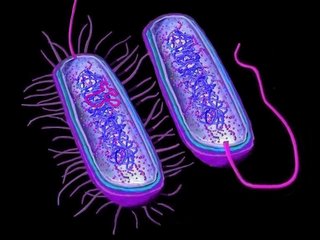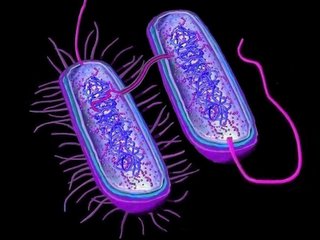Conjugation
Conjugation enables bacteria to exchange genetic material because of tube-like connections called pili.
Conjugation is often likened to a form of sexual reproduction or mating, though it is merely a process by which donor bacteria deliver genetic material to recipient bacteria, utilizing tube-like connections called pili.
Bacteria often contain small circular, double-stranded DNA molecules that are termed plasmids. Bacterial plasmids are not connected to the main bacterial chromosomes and replicate independently. The donor bacterium contains conjugative or mobilizable genetic elements, usually a conjugative plasmid or episome plasmid that can integrate itself into the bacterial chromosome by genetic recombination. One such conjugative plasmid is called the F-plasmid. This is an episome about 100 thousand base-pairs in length, which carries its own origin of replication, called oriV. Most conjugative plasmids have systems ensuring that the recipient cell does not already contain a similar element, ensuring that there is only one copy of the F-plasmid in the F-positive bacterium. diagram of conjugation events diagram of molecular events

One cell contains an F-plasmid (pink), distinct from the prokaryotic genome (blue). The cell with an F-plasmid also possesses pili, which make contact with the F-negative cell, which does not have pili (top right diagram).

The middle diagram (right) indicates passage of genetic material through a pilum from the F+ bacterium to a F- bacterium. This mechanism is under debate. (Compare with a 27,000 x magnification tem image tem conjugation E. coli)

Transfer through the pili (middle, right) may not be a strictly accurate depiction of the actual transfer mechanism. The mechanism utilizes proteins coded by the tra or trb loci, and these may open a channel between the bacteria (bottom diagram). In this case, the pili are probably utilized to anchor and draw together the donor and recipient bacteria (top diagram). (Compare with conjugation in alga Conjugation of Spirogyra and a protist Conjugation of Paramecium.)
Once conjugation has been initiated by a mating signal, a complex of proteins called the relaxosome opens up one plasmid DNA strand at the origin of transfer, or oriT. The relaxosome system of the F-plasmid system comprises proteins TraI, TraY, TraM, and a protein that functions as the integrated host factor, IHF. The transferred strand – the T-strand – is unwound from the duplex before transfer into the recipient bacterium in a 5'-terminus to 3'-terminus direction. The remaining strand is replicated. Replication in concert with conjugation is termed conjugative replication, and is similar to the rolling circle replication of lambda phage. Replication may also occur independent of conjugative action – this is vegetative replication, and begins at the oriV.
Conjugation is often likened to a form of sexual reproduction or mating, though it is merely a process by which donor bacteria deliver genetic material to recipient bacteria, utilizing tube-like connections called pili.
Bacteria often contain small circular, double-stranded DNA molecules that are termed plasmids. Bacterial plasmids are not connected to the main bacterial chromosomes and replicate independently. The donor bacterium contains conjugative or mobilizable genetic elements, usually a conjugative plasmid or episome plasmid that can integrate itself into the bacterial chromosome by genetic recombination. One such conjugative plasmid is called the F-plasmid. This is an episome about 100 thousand base-pairs in length, which carries its own origin of replication, called oriV. Most conjugative plasmids have systems ensuring that the recipient cell does not already contain a similar element, ensuring that there is only one copy of the F-plasmid in the F-positive bacterium. diagram of conjugation events diagram of molecular events

One cell contains an F-plasmid (pink), distinct from the prokaryotic genome (blue). The cell with an F-plasmid also possesses pili, which make contact with the F-negative cell, which does not have pili (top right diagram).

The middle diagram (right) indicates passage of genetic material through a pilum from the F+ bacterium to a F- bacterium. This mechanism is under debate. (Compare with a 27,000 x magnification tem image tem conjugation E. coli)

Transfer through the pili (middle, right) may not be a strictly accurate depiction of the actual transfer mechanism. The mechanism utilizes proteins coded by the tra or trb loci, and these may open a channel between the bacteria (bottom diagram). In this case, the pili are probably utilized to anchor and draw together the donor and recipient bacteria (top diagram). (Compare with conjugation in alga Conjugation of Spirogyra and a protist Conjugation of Paramecium.)
Once conjugation has been initiated by a mating signal, a complex of proteins called the relaxosome opens up one plasmid DNA strand at the origin of transfer, or oriT. The relaxosome system of the F-plasmid system comprises proteins TraI, TraY, TraM, and a protein that functions as the integrated host factor, IHF. The transferred strand – the T-strand – is unwound from the duplex before transfer into the recipient bacterium in a 5'-terminus to 3'-terminus direction. The remaining strand is replicated. Replication in concert with conjugation is termed conjugative replication, and is similar to the rolling circle replication of lambda phage. Replication may also occur independent of conjugative action – this is vegetative replication, and begins at the oriV.








































0 Glossary:
Post a Comment
<< Home